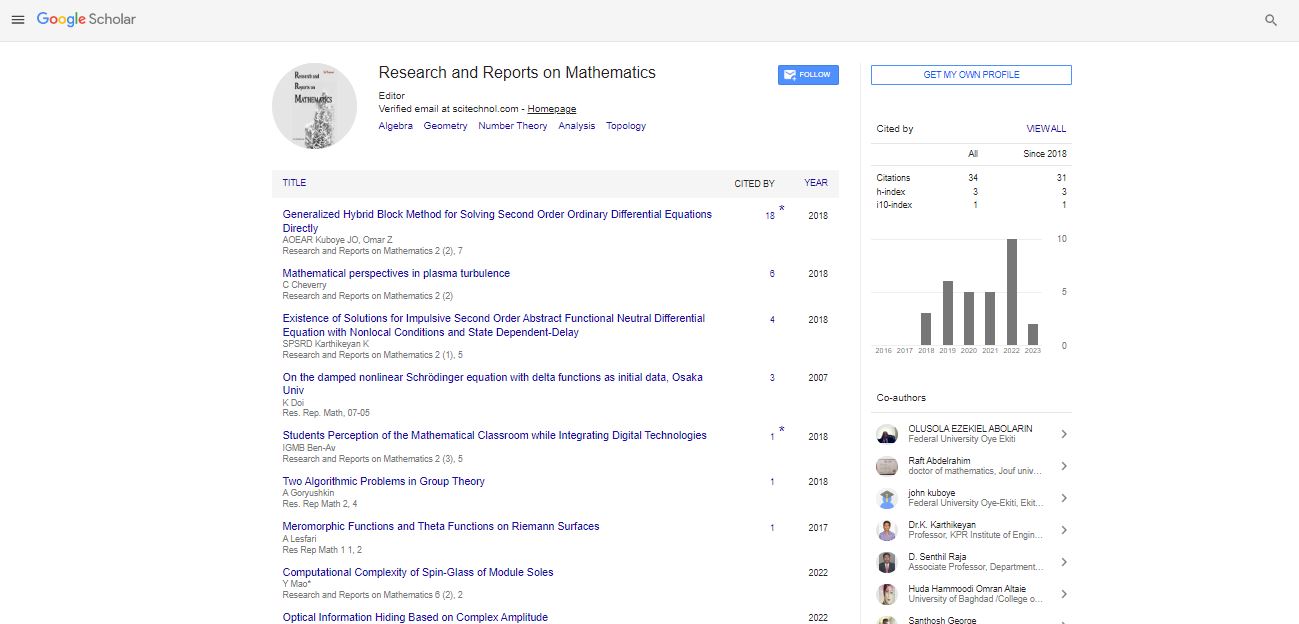Opinion Article, Res Rep Math Vol: 8 Issue: 1
The Crucial Calculus: Mathematics Empowering Machine Learning
Sung Bong*
Department of Applied Mathematics and Computer Science, University of Denmark, Denmark
- *Corresponding Author:
- Sung Bong
Department of Applied Mathematics and Computer Science,
University of Denmark,
Denmark
E-mail: sung123@gmail.com
Received date: 27 October, 2023, Manuscript No. RRM-23-118498;
Editor assigned date: 30 October, 2023, PreQC No. RRM-23-118498 (PQ);
Reviewed date: 13 November, 2023, QC No. RRM-23-118498;
Revised date: 11 January, 2024, Manuscript No. RRM-23-118498 (R);
Published date: 18 January, 2024, DOI: 10.4172/rrm.1000226
Citation: Bong S (2024) The Crucial Calculus: Mathematics Empowering Machine Learning. Res Rep Math 8:1.
Description
Machine learning has emerged as a transformative technology, influencing various aspects of our daily lives, from recommendation systems to self-driving cars. At the heart of this technology lies a complex mathematical foundation. In this manuscript, we delve into the pivotal role of mathematics in machine learning, exploring the mathematical concepts and techniques that underpin machine learning algorithms. We discuss linear algebra, calculus, statistics, and optimization as the foundational pillars of machine learning, illustrating how these mathematical tools enable machines to learn and make predictions.
Machine learning, a subfield of artificial intelligence, has rapidly become an integral part of our modern technological landscape. From natural language processing to image recognition, machine learning algorithms are fueling innovation and reshaping industries. However, beneath the surface of these intelligent systems, there is a rich mathematical framework that provides the necessary tools for machines to learn from data and make predictions.
Vectors and matrices
Linear algebra forms the backbone of machine learning. Vectors and matrices are the fundamental data structures used to represent data, features, and model parameters. Matrix operations, such as matrix multiplication, transpose, and inversion, are essential for transforming and manipulating data.
Eigenvalues and eigenvectors play a crucial role in dimensionality reduction techniques like Principal Component Analysis (PCA) and in solving systems of linear equations. They help capture the most important directions in data.
Derivatives: Calculus is central to understanding the behavior of machine learning algorithms. Derivatives, which indicate how a function changes with respect to its inputs, are used in gradient-based optimization. Gradient descent, a common optimization technique, relies on derivatives to iteratively update model parameters for better performance.
Machine learning models aim to minimize a cost function, which quantifies the difference between predicted and actual outcomes. Calculus is employed to find the minimum of this function, allowing the model to learn from data and adapt its parameters.
Probability and statistics
Probabilistic models are prevalent in machine learning. Understanding probability distributions, such as the Gaussian distribution, is critical for modeling uncertainty and making probabilistic predictions.
Statistics is essential for hypothesis testing, confidence intervals, and model evaluation. Cross-validation and hypothesis tests help assess the performance and reliability of machine learning models.
Machine learning algorithms
Machine learning algorithms, from linear regression to deep neural networks, are mathematical models designed to learn patterns and make predictions. These models use the mathematical concepts of linear algebra, calculus, and statistics to adjust their parameters based on data.
Machine learning relies on vast datasets to train models and make predictions. The mathematical tools discussed in this manuscript enable machines to analyze data, discover patterns, and generalize from observed examples.
As machine learning continues to advance, so does the need for more sophisticated mathematical techniques. Future research will likely focus on developing more robust and efficient algorithms, understanding the theoretical underpinnings of deep learning, and addressing ethical considerations related to the use of mathematical models in decision-making processes.
Conclusion
Mathematics is the key that unlocks the potential of machine learning. It provides the formalism and tools necessary to understand, design, and optimize machine learning models. By embracing the mathematical foundations of machine learning, we can harness its power to solve complex problems and drive innovation in a wide range of domains.
 Spanish
Spanish  Chinese
Chinese  Russian
Russian  German
German  French
French  Japanese
Japanese  Portuguese
Portuguese  Hindi
Hindi 